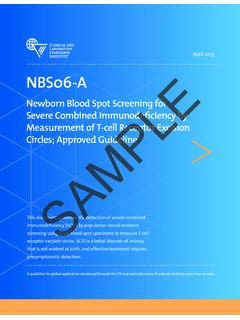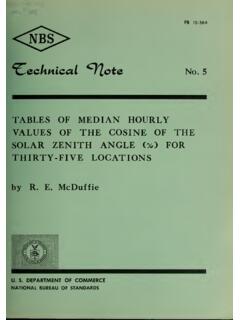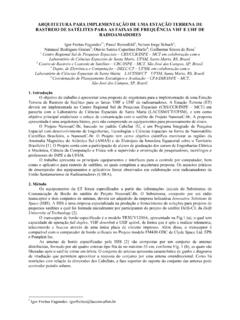Transcription of Example Design of a Yagi-Uda Antenna
1 1 / 9 Example Design of a Yagi-Uda Antenna Problem: Design a Yagi-Uda Antenna with a gain of at least 10 dBi to receive television channel 43 (UHF) for a cable-ready television. Design Steps: 1. Select or specify Design parameters: a. Desired directivity- select 5 element Yagi-Uda Antenna from Table which has a directivity of dBd = + = dBi. [Note: For a Yagi-Uda Antenna , gain directivity.] b. Design Frequency- Channel 43 644-650 MHz , so f = 647 MHz. c. Desired input impedance- R0 = 75 2. Select diameter d of elements and diameter D of metallic supporting boom (optional, only necessary if a metallic boom is to be used) based on mechanical considerations ( , strength, rigidity) and parts availability (refer to Table 1).
2 Element diameter- d = 1/4 = cm (use brass pipe) Boom diameter- D = 5/8 = cm (use 1/2 copper pipe) 3. Calculate Design wavelength . Use to calculate s12 (reflector-driven element spacing) and sij [driven-director & director-director spacing(s)] using Table values. 863* cm647 *10cf Per Table , s12 = sij = = cm 2 / 9 Table OPTIMIZED UNCOMPENSATED LENGTHS OF PARASITIC ELEMENTS FOR Yagi-Uda ANTENNAS OF SIX DIFFERENT LENGTHS d/ = s12 = LENGTH OF Yagi-Uda (IN WAVELENGTHS) LENGTH OF REFLECTOR (l1/ ) LENGTH OF DIRECTORS, l3 l4 l5 l6 l7 l8 l9 l10 l11 l12 l13 l14 l15 l16 l17 SPACING BETWEEN DIRECTORS (sij/ ) DIRECTIVITY RELATIVE TO HALF-WAVE DIPOLE (dB) Design CURVE (SEE FIGURE ) (A) (B) (B) (C) (B) (D) SOURCE: Peter P.
3 Viezbicke, yagi Antenna Design , nbs technical note 688 , December 1976. 3 / 9 Table 1 Available tubing/pipe/rod sizes Nominal Diameter Outer Diameter* (inches) (cm) (inches) (cm) 3/32 3/32 1/8 1/8 5/32 5/32 3/16 3/16 7/32 7/32 1/4 1/4 9/32 9/32 5/16 5/16 11/32 11/32 3/8 3/8 13/32 13/32 7/16 7/16 1/2 1/2 1/2 9/16 1/2 5/8 3/4 7/8 * For brass tubing/pipe/rods, the nominal and outer diameters are the same ( , wall thickness is negligible). For copper pipes, the wall thickness is substantial and should be measured as it varies between manufacturers. 4 / 9 4.
4 Calculate d / Is d / If not, go to step 2 and reconsider selection of d. d / = = Within d / range. 5. If a metal boom is used, calculate D / Is D / If not, go to step 2 and reconsider selection of D. D / = = Within D / range. 6. If d / = , go to step 11 (no element diameter length corrections required). If d/ , the elements lengths must be corrected. Plot the lengths of the reflector (element 1) and first director (element 3) from Table on the appropriate Design curves on Figure (should fall on or near vertical line drawn from d / = ). Label these points l1 and l3 respectively. On Design curves B at d / = , plot- l1 = l3 = 7. Draw a vertical line from d / = through reflector and director Design curves B, where this line intersects the curves is the corrected lengths of the reflector l1 and first director l3.
5 The length l3 should be used for any other directors that are the same original length as l3. Label and read the corrected (for element diameter) lengths- l1 = l3 = l5 = 5 / 9 8. Measure and label the arc length l between l3 and l3 along the Design curve. Using ruler, l = cm. 9. Plot the remaining original optimized director lengths from Table on the appropriate director Design curve on Figure and label li On director Design curve B, plot length of fourth director- l4 = 6 / 9 10. To find the corrected (for element diameter) length(s) for the remaining directors, move l from li (same direction as between l3 and l3 ) to the corrected length li.
6 Move l = cm from l4 = and read l4 = 11. If a metal boom is used (else, skip to next step), the element lengths must be lengthened to compensate for it. On Figure , draw a vertical line from D/ = through the curve. Draw a horizontal line from the intersection to the left axis of the figure and read the compensation length. The final lengths of the elements (label li) are found by adding this length to the original (Table ) or the corrected (for element diameter) element lengths. From Figure , read compensation length = l1 = l1 + = + = = cm l3 = l5 = l3 + = + = = cm l4 = l4 + = + = = cm 12. Design matching network ( , Gamma match, ..) to connect the Antenna to the selected transmission line. The length of the driven element is empirically adjusted to achieve a match at the Design frequency.
7 Typically, it has a length between that of the reflector and the first director. l1 = cm < l2 < l3 = cm For drawing, use simple average l2 = cm 7 / 9 5 element, channel 43 Yagi-Uda Antenna w/ boomBoom1 = (= )S 12 = = 5/8 = cml1 = = = = = = 1/4 = 8 / 9 5 element, channel 43 Yagi-Uda Antenna (No Boom)DirectorsDrivenElement(element spacing = = )S l 1= 2= 3 = 5 = 4 = = 1/4 = NEC-2 Input file CM Yagi-Uda Antenna for UHF channel 43 (NO BOOM) CM THIS FILE IS USED TO DETERMINE INPUT IMPEDANCE OF THE DRIVEN CM ELEMENT OF A 5 ELEMENT Antenna . CENTER FREQUENCY IS 647 MHz CM W/ WAVELENGTH OF m.
8 CM THE DIMENSIONS ARE: CM element diameters d= , radius a=d/2= , CM l1= l= , l3=l5= l= , l4= l= , CM driven element l2=(l1+l3)/2= l= CM ELEMENT SPACINGS Sij= l= CM SELECT SEGMENT LENGTH OF APPROX. l CE THE DRIVEN SEGMENT IS #9 on l2 Tag 2. GW 1 17 !Reflector GW 2 17 !Driven GW 3 15 !Director 1 GW 4 15 !Director 2 GW 5 15 !Director 3 GE 0 0 EK 0 FR 0 1 0 0 647 0 EX 0 2 9 0 RP 0 2 2 0000 PT -1 XQ 0 EN 9 / 9 NEC-2 Output file <snip> - - - STRUCTURE SPECIFICATION - - - <snip> WIRE NO. OF FIRST LAST TAG NO. X1 Y1 Z1 X2 Y2 Z2 RADIUS SEG.
9 SEG. SEG. NO. 1 17 1 17 1 2 17 18 34 2 3 15 35 49 3 4 15 50 64 4 5 15 65 79 5 TOTAL SEGMENTS USED= 79 <snip> - - - - - - FREQUENCY - - - - - - FREQUENCY= +02 MHZ WAVELENGTH= METERS <snip> - - - Antenna INPUT PARAMETERS - - - TAG SEG. VOLTAGE (V) CURRENT (A) IMPEDANCE (OHMS) ADMITTANCE (S) <snip> NO. NO. REAL IMAG. REAL IMAG. REAL IMAG REAL IMAG. <snip> 2 26 +01 +01 <snip> - - - RADIATION PATTERNS - - - - - ANGLES - - - POWER GAINS - <snip> - - - E(THETA) - - - <snip> THETA PHI MAJOR <snip> DEGREES DEGREES DB <snip> <snip> <snip> <snip>










